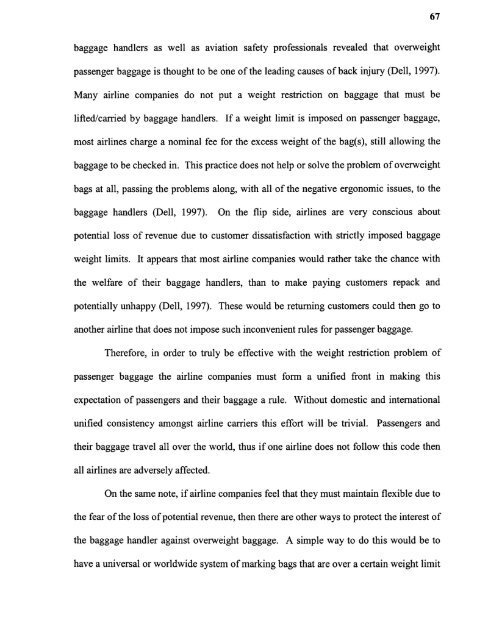An ergonomic assessment of the airline baggage handler
An ergonomic assessment of the airline baggage handler
An ergonomic assessment of the airline baggage handler
You also want an ePaper? Increase the reach of your titles
YUMPU automatically turns print PDFs into web optimized ePapers that Google loves.
67<strong>baggage</strong> <strong>handler</strong>s as well as aviation safety pr<strong>of</strong>essionals revealed that overweightpassenger <strong>baggage</strong> is thought to be one <strong>of</strong> <strong>the</strong> leading causes <strong>of</strong> back injury (Dell, 1997).Many <strong>airline</strong> companies do not put a weight restriction on <strong>baggage</strong> that must belifted/carried by <strong>baggage</strong> <strong>handler</strong>s. If a weight limit is imposed on passenger <strong>baggage</strong>,most <strong>airline</strong>s charge a nominal fee for <strong>the</strong> excess weight <strong>of</strong> <strong>the</strong> bag(s), still allowing <strong>the</strong><strong>baggage</strong> to be checked in. This practice does not help or solve <strong>the</strong> problem <strong>of</strong> overweightbags at all, passing <strong>the</strong> problems along, with all <strong>of</strong> <strong>the</strong> negative <strong>ergonomic</strong> issues, to <strong>the</strong><strong>baggage</strong> <strong>handler</strong>s (Dell, 1997). On <strong>the</strong> flip side, <strong>airline</strong>s are very conscious aboutpotential loss <strong>of</strong> revenue due to customer dissatisfaction with strictly imposed <strong>baggage</strong>weight limits. It appears that most <strong>airline</strong> companies would ra<strong>the</strong>r take <strong>the</strong> chance with<strong>the</strong> welfare <strong>of</strong> <strong>the</strong>ir <strong>baggage</strong> <strong>handler</strong>s, than to make paying customers repack andpotentially unhappy (Dell, 1997). These would be returning customers could <strong>the</strong>n go toano<strong>the</strong>r <strong>airline</strong> that does not impose such inconvenient rules for passenger <strong>baggage</strong>.Therefore, in order to truly be effective with <strong>the</strong> weight restriction problem <strong>of</strong>passenger <strong>baggage</strong> <strong>the</strong> <strong>airline</strong> companies must form a unified front in making thisexpectation <strong>of</strong> passengers and <strong>the</strong>ir <strong>baggage</strong> a rule. Without domestic and internationalunified consistency amongst <strong>airline</strong> carriers this effort will be trivial. Passengers and<strong>the</strong>ir <strong>baggage</strong> travel all over <strong>the</strong> world, thus if one <strong>airline</strong> does not follow this code <strong>the</strong>nall <strong>airline</strong>s are adversely affected.On <strong>the</strong> same note, if <strong>airline</strong> companies feel that <strong>the</strong>y must maintain flexible due to<strong>the</strong> fear <strong>of</strong> <strong>the</strong> loss <strong>of</strong> potential revenue, <strong>the</strong>n <strong>the</strong>re are o<strong>the</strong>r ways to protect <strong>the</strong> interest <strong>of</strong><strong>the</strong> <strong>baggage</strong> <strong>handler</strong> against overweight <strong>baggage</strong>. A simple way to do this would be tohave a universal or worldwide system <strong>of</strong> marking bags that are over a certain weight limit
















